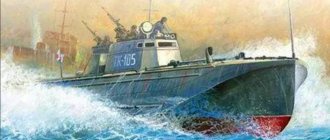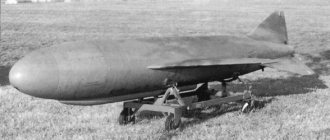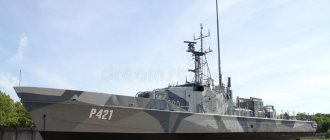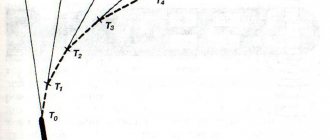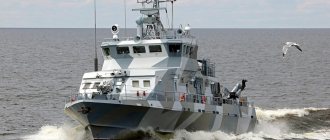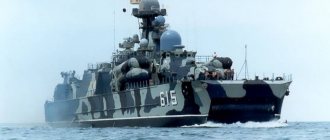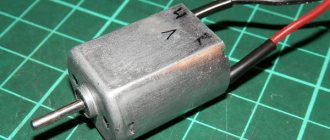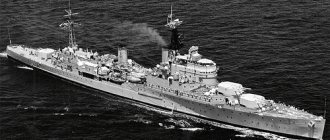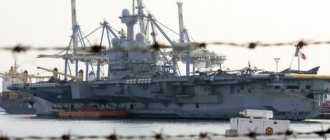On March 14, 1927, the first Soviet torpedo boat, designed by aircraft designer Andrei Tupolev, arrived in Sevastopol
These nimble boats became one of the main symbols of the Soviet navy during the Great Patriotic War. They can be found standing on pedestals and swaying on the waves near museum walls; they are often depicted on postcards dedicated to the war years. They were the most massive ships in the RKKF at the beginning of the war and took on a colossal load, carrying out not only their direct task - torpedo attacks, but also performing many other tasks, and became indispensable for both the fleet and the army.
Torpedo boat ANT-3 “Pervenets” in Sevastopol Bay, spring 1927
Source: wiki.wargaming.net
Historical reference
A torpedo boat is a small combat vessel that is designed to destroy military ships and transport ships with shells. During World War II, it was used many times in military operations with the enemy.
By that time, the naval forces of the main Western powers had a small number of such boats, but their construction rapidly increased by the time hostilities began. On the eve of the Great Patriotic War, there were almost 270 boats equipped with torpedoes in the Soviet Union. During the war, more than 30 models of torpedo boats were created and more than 150 were received from the allies.
Heirs of mine boats
Strictly speaking, the championship in the combat use of torpedo boats belongs to Russia, and it did this back in the 19th century. Those boats were called mine boats and were small ships based on mine transport. Before the attack, they were launched into the water, and in order to release “Whitehead mines,” as the torpedoes were then called, they had to just as carefully lower them into the water and send them on their way to the target. This is how the mine boats “Chesma” and “Sinop”, based on the transport “Grand Duke Constantine”, acted on January 26 (14 according to the old style), carrying out the world’s first effective torpedo attack on the Turkish gunboat “Intibah”.
However, until the end of the First World War, when similar ships were already being built in full swing in other maritime powers, no fast torpedo boats capable of firing on the move appeared in Russia. And immediately after the October Revolution, there could be no talk of them at all: when in 1919 the command of the Red Fleet turned to the top with a request to order the construction of this type of ship, the answer was simple and laconic: there is no technical possibility. And only in 1925, the People's Commissariat for Maritime Affairs gave TsAGI the task of developing a torpedo boat. A team led by aircraft designer Andrei Tupolev got to work, and the created boat inherited a lot from aviation. In essence, it was an enlarged float of a heavy seaplane with a crew of three people and one 450-mm torpedo in the stern tray, which was dropped as the boat moved. The material for the ship was also chosen from aviation - chain mail aluminum (later became duralumin), recently created by Soviet metallurgists. This boat received the index ANT-3, and then its own name “Firstborn”: it was the first ship built from start to finish in Soviet times!
Sh-4 type torpedo boat of the Baltic Fleet, second half of the 1930s
Source: and-kin2008.narod.ru
History of the torpedo ship
Back in 1927, the TsAGI team developed a project for the first Soviet torpedo ship, headed by A. N. Tupolev. The ship was given the name “Perbornets” (or “ANT-3”). It had the following parameters (unit of measurement - meter): length 17.33; width 3.33 and draft 0.9. The power of the vessel was 1200 hp. s., tonnage - 8.91 tons, speed - as much as 54 knots.
The armament on board consisted of a 450 mm torpedo, two machine guns and two mines. The experimental production boat became part of the Black Sea naval forces in mid-July 1927. The institute continued to work, improving the units, and in the first month of autumn 1928 the serial boat “ANT-4” was ready. Until the end of 1931, dozens of ships were launched, which were called “Sh-4”. Soon, the first formations of torpedo boats appeared in the Black Sea, Far Eastern and Baltic military districts. The Sh-4 ship was not ideal, and the fleet leadership ordered TsAGI a new boat in 1928, which was later named G-5. It was a completely new ship.
Soviet "Firstborn"
On March 6, 1927, the ANT-3, built in Moscow, was loaded onto a train and sent to Sevastopol, where it arrived on March 14. Three days later, tests began, and the boat reached an incredible speed - up to 54 knots, that is, more than 100 km/h! True, he could only go so fast on calm water, which was determined by the same design features of the ship that ensured high speed. The absence of a developed keel and the presence of a redan, that is, a protrusion on the bottom that allowed the boat to go on planing (that is, rest on the water only with the back half of the bottom, reducing drag) precisely reduced its seaworthiness. But all this did not bother the sailors: according to the concept of that time, the new torpedo boats were planned, like the mine boats of the Crimean War, to be delivered to the theater of operations on large warships such as light cruisers, and only launched there. And although this concept was soon abandoned, they no longer began to remake the nimble fast boats.
The first production ships, successors to the Pervenets, were torpedo boats of the Sh-4 type, which were put into service in 1928. They were slightly modernized ships of the same type, but received more powerful main weapons: two torpedo tubes instead of one. Due to this, their maximum speed dropped slightly and amounted to “only” 46 knots, that is, 85 km/h, but this was enough to be able to set an attack course, fire torpedoes and leave their course. This was, perhaps, the main drawback of the Sh-4: in order to shoot at a target, the boat had to have a speed of at least 17-18 knots, because only this would allow it to have time to turn away from the torpedoes, which were dropped from the trays back along the ship’s path, but the tail partly forward and immediately began to move. And if the torpedo boat did not have time to dodge its own torpedoes, it could become their victim.
Soviet torpedo boat TKA-15 type D-3 of the Northern Fleet in the port of Polyarny, 1942
Source: waralbum.ru
Over four years, the Red Fleet received 59 ships of the Sh-4 type. They have proven themselves well, but during the operation of the “fours” it became clear that the fleet needs more seaworthy and “long-range” torpedo boats with more modern weapons than pre-revolutionary 450 mm torpedoes. The creation of such ships was again entrusted to Andrei Tupolev, who, based on the Sh-4 in 1933, developed a new torpedo boat of the G-5 series, which was destined to become the most massive ship of this type in the Soviet Navy: 307 units were built!
Torpedo ship model "G-5"
The planing vessel "G-5" was tested in December 1933. The ship had a metal hull and was considered the best in the world both in terms of technical characteristics and weapons. Serial production of "G-5" dates back to 1935. By the beginning of World War II, it was the basic type of boat of the USSR Navy. The speed of the torpedo boat was 50 knots, the power was 1700 hp. s., and was armed with two machine guns, two 533 mm torpedoes and four mines. Over the course of ten years, more than 200 units of various modifications were produced.
During the Great Patriotic War, G-5 boats hunted enemy submarines, guarded ships, carried out torpedo attacks, landed troops, and escorted trains. The disadvantage of torpedo boats was the dependence of their operation on weather conditions. They could not be at sea when the sea level reached more than three points. There were also inconveniences with the placement of paratroopers, as well as with the transportation of goods due to the lack of a flat deck. In this regard, just before the war, new models of long-range boats “D-3” with a wooden hull and “SM-3” with a steel hull were created.
introduction
P
sailing on a torpedo boat has always been the secret passion of a young man in love with the sea. And, if it was destined to come true, the young naval officer or sailor, it seemed, had nothing more to desire in this world.
This is what I and my comrades thought, who in the mid-thirties were sent to one of the six torpedo boats of the 1st half-flotilla, based in Kiel. There simply were no other torpedo boats in the German Navy in 1936, since the Treaty of Versailles prohibited their design and construction. Only the London Naval Treaty with Great Britain, signed in 1935, freed our fleet from the shackles of the Versailles dictate.
At the outbreak of World War II, September 3, 1939, there were two fleets of torpedo boats available. Each had six first-line boats and two reserve ones - not very impressive power when it comes to a war against a great naval power such as Britain.
The task of the torpedo boats was to conduct night torpedo attacks as part of the coastal defense. Thanks to the impressive cruising speed (26–28 knots) and the presence of an escort ship, which had torpedoes, fuel, ammunition and food on board, both flotillas had exceptionally high mobility. For example, they could suddenly move from Kiel to Pillau in one night and the very next night they were in full combat readiness for action at a great distance from their home harbor. In the North Sea, boats could operate from Wilhelmshaven, Helgoland or Borkum all the way to the northern tip of the English Channel - of course, if the weather allowed them to go to sea. Of course, small boats with a displacement of only 82 tons could only be used if the wind force did not exceed 4–5 points, and the sea state did not exceed 3–4 points.
The strength of the boat, equipped with two torpedo tubes and having four torpedoes on board, lay in the destructive power of its weapons, capable of disabling or even sinking a large ship. Its weakness was its low protection; the boat could be sunk by a single hit from a 10.5 cm shell.
Both of these factors limited the use of boats to night hours. The cover of night darkness was necessary in order to approach unnoticed to a distance of 500–800 meters to launch a torpedo. The attacks were carried out against an invariably superior enemy - the only exception was single unprotected transports, but these were very rare.
The artillery armament consisted of a 2-cm MG C/30 automatic cannon and a 9-mm machine gun mounted on a tripod at the stern. To hunt submarines, each boat had 6 depth charges on board. In addition, it was possible to take on board 6 large or 8 small sea mines.
The maximum speed of the boats was 34 knots, the range of action at a cruising speed of 26 knots was 320 miles. Communication was carried out in the VHF range using radio stations with a power of 40/70 watts. Two devices installed at the stern provided a smoke screen, with the help of which the boats on bright nights could hide from the sight of the enemy, who could use superior artillery against them.
The heart of the boat was the propulsion system. It consisted of three 16-cylinder engines located in two separate engine compartments. The total power of these diesel engines was 3600 hp, transmitted to three propellers. The Bremen shipyard "Lursen", which had the greatest experience in the construction of torpedo boats, developed a special device called the "Lursen Effect". It consisted of two rudders located behind the propellers, which created additional water pressure under the stern, which made it possible to increase the maximum speed by another 1-2 knots.
The crew of each boat included one officer, 5 non-commissioned officers and 12 sailors. In wartime, one more non-commissioned officer and 2 sailors were added to this number. This was very little, so even junior crew members bore great responsibility and had to make their own decisions and take initiative. Of course, it is necessary to mention the personnel of the headquarters, bases and the crew of the escort ship, since it was these people who were supposed to create the prerequisites for the successful use of combat boats.
During the war, 215 torpedo boats were built, including 145 at the Lürssen shipyard in Bremen. 96 boats were lost from enemy actions.
In mid-May 1940, I was on the cruiser Emden, which was stationed in Oslo, where the ship arrived on April 9–10 with an landing group of 600 soldiers of the ground forces and naval artillery after the battle in the Oslofjord. It was then that I received a telegraphic order appointing me immediately as commander of the 3rd Torpedo Boat Flotilla. This was great news, especially after my requests to be transferred to the submarine fleet in September and November 1939 were rejected.
Although my wish to sail in a submarine was not fulfilled, I was glad for the new assignment. In view of my young age and low rank, I did not even hope to receive command of a flotilla of torpedo boats. In 1936-1937 I commanded the S-11 and S-15 boats and therefore did not need any preliminary training. I knew what a torpedo boat was, what weapons it had, what its tactics should be, and how it should be commanded.
A three-engine Ju-52 took me from Oslo-Forneby to Berlin-Staaken, and on the evening of May 22 I arrived in Kiel. What was waiting for me here? What does the 3rd flotilla look like? How many boats and trained crews does it have? And most importantly: when will she be able to go to the English Channel, where the 1st and 2nd flotillas are already operating, having achieved success in attacks on the convoys of the British Expeditionary Force, traveling from Calais and Dunkirk to Dover and the Thames Estuary?
Torpedo leader
Nekrasov, who was the head of the experimental design team for the development of gliders, and Tupolev in 1933 developed the design of the G-6 ship. He was the leader among the available boats. According to the documentation, the vessel had the following parameters:
- displacement 70 t;
- six 533 mm torpedoes;
- eight engines of 830 hp each. With.;
- speed 42 knots.
Three torpedoes were fired from torpedo tubes located at the stern and shaped like a trench, and the next three were fired from a three-tube torpedo tube, which could be turned and was located on the deck of the ship. In addition, the boat had two cannons and several machine guns.
Planing torpedo ship "D-3"
USSR torpedo boats of the D-3 brand were produced at the Leningrad plant and Sosnovsky, which was located in the Kirov region. The Northern Fleet had only two boats of this type when the Great Patriotic War began. In 1941, another 5 ships were produced at the Leningrad plant. Only starting in 1943, domestic and allied models began to enter service.
The D-3 vessels, unlike the previous G-5, could operate at a longer distance (up to 550 miles) from the base. The speed of the new brand of torpedo boat ranged from 32 to 48 knots, depending on engine power. Another feature of the “D-3” was that it was possible to fire a salvo from them while stationary, and from the “G-5” units - only at a speed of at least 18 knots, otherwise the fired missile could hit the ship. On board the ship were:
- two 533 mm torpedoes of the thirty-ninth model:
- two DShK machine guns;
- Oerlikon cannon;
- Colt Browning coaxial machine gun.
The hull of the ship "D-3" was divided by four partitions into five waterproof compartments. Unlike boats of the G-5 type, D-3 were equipped with better navigation equipment, and a group of paratroopers could move freely on the deck. The boat could take on board up to 10 people, who were accommodated in heated compartments.
From the author
P
30 years have passed since the end of World War II, and describing what we experienced in those years from memory would be a dubious undertaking. It was only after the British Admiralty returned my flotilla's war logs to us several years ago and I was able to look into them that I began writing this book. At first it was intended only for my old comrades from the 3rd Torpedo Boat Flotilla, which I commanded from the formation of the formation on May 15, 1940 until July 7, 1943. For many years, together with me, they bore the burden of fighting against superior enemy forces on their shoulders. Often they had to fight the enemy night after night and achieve great success, completely trusting their leadership.
With my notes, I want to call for our comrades who died and died from their wounds not to be forgotten. Fighting for the people and fatherland, they sacrificed the most valuable thing they had - their lives.
When you re-read these notes, facts come to mind that seemed long forgotten. Today, hardly any of us could remember who and when called us the “African Flotilla”. In fact, this name was given to us by the infantrymen, soldiers of the Afrika Korps, who, like us, wore a brown and green armband with the inscription “Africa”.
While working on the manuscript, the idea came to me to expand the scope of the project. I decided to look at the operations of the flotilla, which fought in a rather controversial theater of war, and its tasks against the backdrop of the larger picture of the world war, as well as analyze the overall strategy and its effectiveness. In thinking about how best to structure the book, I decided to stick to the battle log and present the events in chronological order. This allowed me to look at successes and failures, right and wrong decisions, possibilities and their limits, issues of organization and management of operations, as well as human relationships and military achievements of commanders, officers and lower ranks. I set out to take a critical look at the achievements and losses in three theaters of war: the English Channel, the eastern Baltic and the Mediterranean - and draw lessons from them. In this case, there arises a natural need to sum up intermediate results again and again in order to evaluate the experience gained.
During the war, we did not and could not know the point of view of the opposite side - how our opponents assessed us, how serious damage they were forced to bear from our actions, and what decisions they made to combat torpedo boats. Many of the successes of the flotilla, for example, the effect of mine laying in front of the strategically important naval and air base of Malta, which was decisive for the outcome of the war in North Africa, are known to us from the work of Captain S.W. Roskilde "War at Sea".
Figures and quotations are taken mainly from Roskilde's war and labor journals. Additional information is obtained from other books about the war. I have to admit that the data on our successful attacks does not always agree with the data from British or Soviet sources.
It is my hope that my book will make some contribution to the assessment of the importance, capabilities and combat value of torpedo boats in the littoral zone, as well as to the debate on the organization of naval forces.
Friedrich Kemnade
Torpedo ship "Komsomolets"
On the eve of World War II, torpedo boats in the USSR received further development. Designers continued to design new and improved models. This is how a new boat called “Komsomolets” appeared. Its tonnage was similar to that of the G-5, its tube torpedo tubes were more advanced, and it could carry more powerful anti-aircraft anti-submarine weapons. For the construction of the ships, voluntary donations from Soviet citizens were attracted, hence their names, for example, “Leningrad Worker” and other similar names.
The hulls of ships manufactured in 1944 were made of duralumin. The interior of the boat included five compartments. Keels were installed along the sides of the underwater part to reduce pitching, and the trough torpedo tubes were replaced with tube apparatus. Seaworthiness increased to four points. Armament included:
- two torpedoes;
- four machine guns;
- depth charges (six pieces);
- smoke equipment.
The cabin, which accommodated seven crew members, was made of seven-millimeter armored sheet. World War II torpedo boats, especially the Komsomolets, distinguished themselves in the spring battles of 1945, when Soviet troops approached Berlin.
Post-war ships
After the war, many countries abandoned the creation of torpedo boats. And they moved on to creating more modern missile ships. Construction continued to be carried out by Israel, Germany, China, the USSR and others. In the post-war period, boats changed their purpose and began to patrol coastal areas and fight enemy submarines.
The Soviet Union presented a Project 206 torpedo boat with a displacement of 268 tons and a length of 38.6 meters. Its speed was 42 knots. The armament consisted of four 533-mm torpedo tubes and two twin AK-230 launchers.
Some countries have begun producing mixed-type boats, using both missiles and torpedoes:
- Israel produced the Dabur boat
- China has developed a combined boat "Hegu"
- Norway built the Hauk
- In Germany it was "Albatross"
- Sweden was armed with the Nordköping
- Argentina had the Intrepid boat.
Albatross Germany 1975
Mistakes made by engineer Tupolev
The torpedo boats (Tupolev's project) were based on a seaplane float. Its top, which influenced the strength of the device, was used by the designer on the boat. The upper deck of the ship was replaced by a convex and steeply curved surface. It was impossible for a person, even when the boat was at rest, to stay on the deck. When the ship was moving, it was completely impossible for the crew to leave the cabin; everything that was on it was thrown off the surface. In wartime, when it was necessary to transport troops on the G-5, military personnel were seated in the chutes that are available at the torpedo tubes. Despite the good buoyancy of the vessel, it is impossible to transport any cargo on it, since there is no space to place it. The design of the torpedo tube, which was borrowed from the British, was unsuccessful. The lowest speed of the ship at which torpedoes were fired was 17 knots. At rest and at a lower speed, a salvo of torpedoes was impossible, since it would hit the boat.
German military torpedo boats
During the First World War, in order to fight British monitors in Flanders, the German fleet had to think about creating new means of fighting the enemy. A solution was found, and in April 1917, the first small fast boat armed with torpedoes was built. The length of the wooden hull was slightly more than 11 m. The ship was propelled by two carburetor engines, which overheated already at a speed of 17 knots. When it increased to 24 knots, strong splashes appeared. One 350 mm torpedo tube was installed in the bow; shots could be fired at a speed of no more than 24 knots, otherwise the boat would hit the torpedo. Despite the shortcomings, German torpedo ships entered mass production.
All ships had a wooden hull, the speed reached 30 knots at a wave of three points. The crew consisted of seven people; on board there was one 450 mm torpedo tube and a machine gun of a rifle caliber. At the time the armistice was signed, the Kaiser's fleet included 21 boats.
All over the world, after the end of the First World War, there was a decline in the production of torpedo ships. Only in 1929, in November, did the Germans accept an order for the construction of a combat boat. The ships released were improved several times. The German command was not satisfied with the use of gasoline engines on ships. While the designers were working to replace them with hydrodynamics, other designs were being refined all the time.
German torpedo boats of World War II
Even before the start of World War II, the German naval leadership set a course for the production of combat boats with torpedoes. Requirements were developed for their shape, equipment and maneuverability. By 1945, it was decided to build 75 ships.
Germany occupied third place in the world leadership in the export of torpedo boats. Before the start of the war, German shipbuilding was working to implement Plan Z. Accordingly, the German fleet had to re-equip itself significantly and have a large number of ships carrying torpedo weapons. With the outbreak of hostilities in the fall of 1939, the planned plan was not fulfilled, and then the production of boats increased sharply, and by May 1945, almost 250 units of Schnellbot-5 alone were put into operation.
The boats, which have a hundred-ton carrying capacity and improved seaworthiness, were built in 1940. Combat ships were designated starting with "S38". It was the main weapon of the German fleet in the war. The armament of the boats was as follows:
- two torpedo tubes with two to four missiles;
- two thirty-millimeter anti-aircraft weapons.
The highest speed of the vessel is 42 knots. 220 ships were involved in the battles of World War II. The German boats at the battle site behaved bravely, but not recklessly. In the last few weeks of the war, the ships were used to evacuate refugees to their homeland.
Interesting and little-known historical facts
Not everyone knows that the Soviet torpedo boats that were used during World War II were huge floats from seaplanes.
In June 1929, aircraft designer Tupolev A. began construction of a planing vessel of the ANT-5 brand, equipped with two torpedoes. The tests carried out showed that the ships have a speed that ships of other countries could not develop. The military authorities were pleased with this fact.
In 1915, the British designed a small boat with enormous speed. Sometimes it was called a “floating torpedo tube.”
Soviet military leaders could not afford to use Western experience in designing ships with torpedo carriers, believing that our boats were better.
The ships built by Tupolev were of aviation origin. This is reminiscent of the special configuration of the hull and the skin of the vessel, made of duralumin material.
